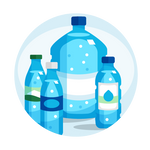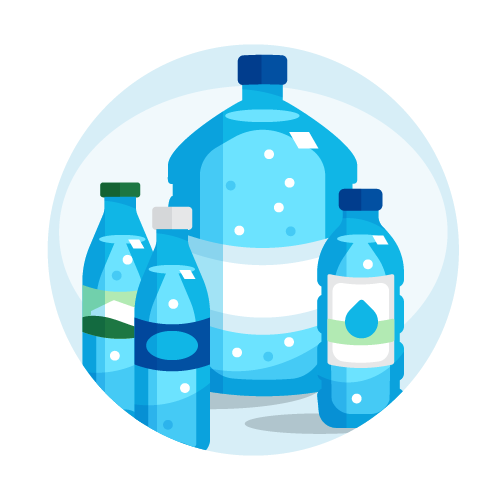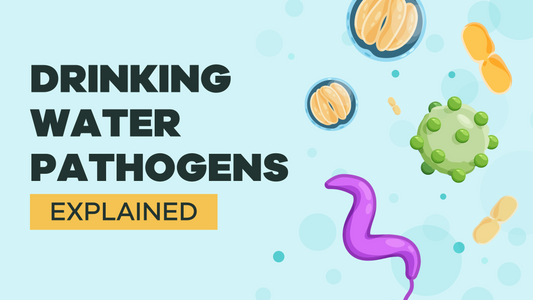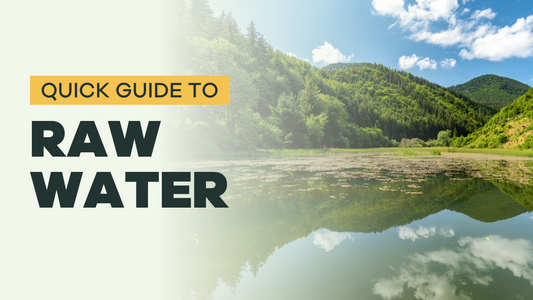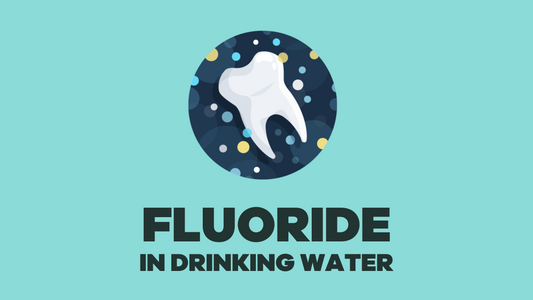
How Is Bottled Water Regulated?
Our blog is written by real experts— not AI. Each guide is carefully reviewed and updated based on the latest research. Plus, with no affiliate links, you can count on unbiased insights you can trust.
There is a widespread perception that bottled water is ‘pure’ and free of contaminants, due in part to misleading marketing, which compounds pre-existing distrust in tap water quality. [1-3] While concern about municipal water supplies is warranted given nationwide exposures to toxic chemicals like PFAS and lead, there is inadequate scientific evidence to suggest that bottled water is always a superior alternative.
It is not widely understood that bottled water is regulated less stringently than tap water in certain respects, nor that a significant fraction of bottled water sold is effectively tap water taken from municipal sources, typically with additional treatment. [1] [3-5] Various studies have shown cases where bottled water contained a wide range of contaminants, including bacteria, heavy metals including lead and antimony, arsenic, volatile and semi-volatile organic contaminants, disinfection by-products, radiological elements, and various PFAS compounds, among many others. [1] [6-13]
To better understand the bottled water industry, it is important to take a look at the regulations that govern it.
The Basics of Federal Bottled Water Laws
In the US, bottled water is federally regulated by the Food and Drug Administration (FDA) while municipal tap water is regulated by the Environmental Protection Agency (EPA). States also have their own regulations for both bottled and tap water, which are sometimes more strict than federal regulations. The FDA regulates food, beverages, cosmetics, and other consumer goods and according to the standards detailed below.
Bottled water is governed by three different standards [4]:
-
A standard of identity, dictating the specifics of what can be considered bottled water and specifying labeling requirements,
-
A standard of quality, dictating acceptable levels of contaminants and water quality parameters, and
-
Good manufacturing practices, regulating the manufacturing facilities that produce and bottle the water.
What Is Considered “Bottled Water”?
Not all water that comes in a bottle or can is regulated the same way. It is possible that products labeled with words like “pure”, “glacial”, and “natural” in your grocery store are not subject to the regulations designed to protect the public from harmful water contaminants. There are very specific standards of identity that determine which products get regulated as bottled water. Both “bottled water” and “drinking water” designations are regulated as bottled water, as well as various, more specific product names. The following excerpt from the Federal Code of Regulations details products that fit the definition of bottled water, which are the products subject to regulations: [4]
-
Purified/demineralized water: The name of water that has been produced by distillation, deionization, reverse osmosis, or other suitable processes … may be “purified water” or “demineralized water.”
-
Artesian water: The name of water from a well tapping a confined aquifer in which the water level stands at some height above the top of the aquifer is “artesian water” or “artesian well water.”
-
Mineral water: The name of water containing not less than 250 parts per million (PPM) total dissolved solids (TDS), coming from a source tapped at one or more bore holes or springs, originating from a geologically and physically protected underground water source, may be “mineral water.”
-
Spring water: The name of water derived from an underground formation from which water flows naturally to the surface of the earth may be “spring water.”
-
Ground water: The name of water from a subsurface saturated zone that is under a pressure equal to or greater than atmospheric pressure is “ground water.”
-
Well water: The name of water from a hole bored, drilled, or otherwise constructed in the ground which taps the water of an aquifer may be “well water.”
Combinations of the above words are also recognized, for example, “purified spring water”. These definitions leave a gap. Many products that could easily be mistaken as “bottled water” are not regulated because they do not fit into these categories. For example, “products labeled as “water,” or as “carbonated water,” “disinfected water,” “filtered water,” “seltzer water,” “soda water,” “sparkling water,” or “tonic water”“ are not regulated by FDA. [4] These products, as well as any others that do not fit the strict standards of identity, are regulated merely as food items and thus subject to good manufacturing practices but none of the standards of quality to which bottled water must adhere.
How Are Bottled Water Regulations Different From Tap Water Regulations?
The standards of quality for bottled water are mostly consistent with those of the EPA for municipal water, but they diverge in a few key areas and are less stringent than standards for municipal water in these instances. [3] [14]
One key area in which the FDA has fallen short in the past is fulfilling its requirement to keep up with EPA regulations for new contaminants in a timely manner. A prime example of the FDA failing to comply with this requirement involves the regulation of bis(2-ethylhexyl) phthalate (DEHP). DEHP is classified by the EPA as a probable human carcinogen and has other adverse health effects, including potential impacts to the liver and endocrine system. [15] The EPA implemented a legally-binding maximum contaminant level (MCL) for DEHP in 1992 but the FDA didn’t follow with a bottled water quality standard until 2012; the FDA was granted deferred action on DEHP in 1996 but still failed to implement a standard for 16 years past the original statutory deadline. [14]

The FDA’s regulations do not require bottled water to retain a disinfectant residual, a practice that is required by the EPA to ensure that microbial contamination is not introduced after water leaves the treatment plant. [5] Note that municipal water travels through a distribution system after treatment and before reaching your tap, whereas bottled water is typically bottled at the source. Another difference is the lack of a minimum fluoride requirement for bottled water. [16] Fluoride is added to municipal water at specified concentrations in order to protect dental health, but research regarding fluoride’s potential negative health impacts at drinking water-relevant concentrations is ongoing. [17]
The FDA does not have the authority to require bottled water samples to be analyzed at certified laboratories, as is required by the EPA for municipal water analyses. [14] The bottled water manufacturers take the required samples themselves and analyze them wherever they see fit. FDA inspectors may visit the bottling facilities to take their own samples on an infrequent basis, but the vast majority of the required water quality analysis is conducted by the bottlers.
In addition, bottled water manufacturers are not required to disclose water quality information on the bottle. Rather, labeling requirements for bottled water are similar to those for labels on food items, listing such information as caloric content, total fat, etc. which are all quite irrelevant to drinking water. This results in inconsistent, voluntary disclosure of water quality information on a brand-by-brand basis. [4] [14]
By contrast, the EPA requires routine analysis and reporting of drinking water quality produced by every public water system nationwide. Water systems are required to share this information publicly with customers on an annual basis. Drinking water treatment plants must also comply with the Public Notification Rule, which requires prompt notification of any drinking water standard violations. [18] [19]
Advanced Bottled Water Test
Test your favorite brand of bottled water to check for metals, minerals, and chemicals related to plastic.
Beyond Bottled Water Quality Standards
Though the FDA is required to implement water quality standards that are at least as strict as those followed by suppliers of tap water, the FDA does not adhere to other EPA requirements like those dictating testing frequency and source water protection.
For example, the EPA is required to monitor total coliform and E. coli in municipal water at many points within the distribution system for a single treatment plant, up to hundreds of locations per quarter depending on the population served. [20] A water bottling plant is only required to test for these constituents once per week.
Many of the regulations meant to protect bottled water are enforced via inspections of the bottling plants, but the FDA allocates very little funding to the enforcement of bottled water regulations. According to a Natural Resources Defense Council (NRDC) survey, as of 1998, the FDA averaged fewer than one staff member dedicated to the development and issuing of bottled water regulations and fewer than one staff member dedicated to the inspection of bottling plants. [1] This stands in stark contrast to the hundreds of staff members at the EPA tasked with creating and enforcing municipal water regulations. There are similar disparities at the state level as well. While this study was over 20 years ago now, the mere fact that this was ever the case is alarming and hopefully the FDA has allotted more resources to bottled water enforcement in the meantime.
Further Limitations of Bottled Water Regulations
The labeling requirements for bottled water are not as rigorous as one may think. For example, the exact sources of the bottled water are not required to be disclosed on product labels. This means that “spring water” is not required to reveal the location of the spring. Also, while a product must specify on the label that it is from municipal sources when this is the case (and it has not been treated further), there is no requirement for the specific sources to be named. If the municipally-sourced water has been treated and reaches the standards of “purified water”, it may be referred to as such and the fact that it is municipal water is not required to be disclosed. [4]
As you can see, bottled water regulations can be confusing and are different from tap water regulations. If you have concerns about your tap water, it is best to get it tested before deciding to purchase bottled water as an alternative. And even if you find contamination in your tap water, it is generally cheaper and more environmentally friendly to get an at-home treatment system rather than buy bottled water. Tap Score’s team of water quality engineers, treatment experts, and chemists are standing by to help you figure out your next steps and answer any questions you may have about your water. Send them a message any time: support@mytapscore.com.
Read More
▾Bottled Water: When Is It Worth It?
7 Pathogens That Contaminate Drinking Water
Heavy Metals Everyone Should Test For
Disinfection Byproducts: The Adverse Effects of Water Chlorination
General Chemistry of Water – SimpleLab Tap Score
Chlorine and Chloramine: Two Ways to Disinfect
Why Is Fluoride Used in Water Treatment?
What Is a Consumer Confidence Report (CCR)?
Testing Your Tap Water–Cheaper and Better Than Bottled Water
Sources and References
▾- Olson, E. D.; Poling, D.; Solomon, G. Bottled Water: Pure Drink or Pure Hype?; Natural Resources Defense Council, 1999; p 133.
- Diduch, M.; Polkowska, Ż.; Namieśnik, J. Factors Affecting the Quality of Bottled Water. J. Expo. Sci. Environ. Epidemiol. 2013, 23 (2), 111–119. https://doi.org/10.1038/jes.2012.101.
- Gleick, P. H. Bottled and Sold: The Story Behind Our Obsession With Bottled Water; Island Press, 2010.
- Federal Code of Regulations Title 21; Vol. 21 CFR §165.110.
- Allen, L.; Darby, J. L. Quality Control of Bottled and Vended Water in California: A Review and Comparison to Tap Water. J. Environ. Health 1994, 56 (8), 17–22.
- Vantarakis, A.; Smaili, M.; Detorakis, I.; Vantarakis, G.; Papapetropoulou, M. Diachronic Long-Term Surveillance of Bacteriological Quality of Bottled Water in Greece (1995–2010). Food Control 2013, 33 (1), 63–67. https://doi.org/10.1016/j.foodcont.2013.01.034.
- Diduch, M.; Polkowska, Ż.; Namieśnik, J. The Role of Heterotrophic Plate Count Bacteria in Bottled Water Quality Assessment. Food Control 2016, 61, 188–195. https://doi.org/10.1016/j.foodcont.2015.09.024.
- Shotyk, W.; Krachler, M. Lead in Bottled Waters: Contamination from Glass and Comparison with Pristine Groundwater. Environ. Sci. Technol. 2007, 41 (10), 3508–3513. https://doi.org/10.1021/es062964h.
- Westerhoff, P.; Prapaipong, P.; Shock, E.; Hillaireau, A. Antimony Leaching from Polyethylene Terephthalate (PET) Plastic Used for Bottled Drinking Water. Water Res. 2008, 42 (3), 551–556. https://doi.org/10.1016/j.watres.2007.07.048.
- Luo, Q.; Liu, Z.; Yin, H.; Dang, Z.; Wu, P.; Zhu, N.; Lin, Z.; Liu, Y. Migration and Potential Risk of Trace Phthalates in Bottled Water: A Global Situation. Water Res. 2018, 147, 362–372. https://doi.org/10.1016/j.watres.2018.10.002.
- Chow, S. J.; Ojeda, N.; Jacangelo, J. G.; Schwab, K. J. Detection of Ultrashort-Chain and Other per- and Polyfluoroalkyl Substances (PFAS) in U.S. Bottled Water. Water Res. 2021, 201, 117292. https://doi.org/10.1016/j.watres.2021.117292.
- Arsenic in Some Bottled Water Brands at Unsafe Levels, Consumer Reports Says
- Bradley, P. M.; Romanok, K. M.; Smalling, K. L.; Focazio, M. J.; Evans, N.; Fitzpatrick, S. C.; Givens, C. E.; Gordon, S. E.; Gray, J. L.; Green, E. M.; Griffin, D. W.; Hladik, M. L.; Kanagy, L. K.; Lisle, J. T.; Loftin, K. A.; Blaine McCleskey, R.; Medlock–Kakaley, E. K.; Navas-Acien, A.; Roth, D. A.; South, P.; Weis, C. P. Bottled Water Contaminant Exposures and Potential Human Effects. Environ. Int. 2023, 171, 107701. https://doi.org/10.1016/j.envint.2022.107701
- United States Congress House Committee on Energy and Commerce Subcommittee on Commerce, Trade, and Consumer Protection. Regulation of Bottled Water: Hearing Before the Subcommittee on Commerce, Trade, and Consumer Protection of the Committee on Energy and Commerce, House of Representatives, One Hundred Eleventh Congress, First Session, July 8, 2009; U.S. Government Printing Office, 2009.
- US EPA. National Primary Drinking Water Regulations. https://www.epa.gov/ground-water-and-drinking-water/national-primary-drinking-water-regulations (accessed 2022-05-01).
- Lalumandier, J. A.; Ayers, L. W. Fluoride and Bacterial Content of Bottled Water vs Tap Water. Arch. Fam. Med. 2000, 9 (3), 246. https://doi.org/10.1001/archfami.9.3.246.
- Grandjean, P. Developmental fluoride neurotoxicity: an updated review. Environ Health 18, 110 (2019). https://doi.org/10.1186/s12940-019-0551-x
- US EPA. CCR Information for Consumers. https://www.epa.gov/ccr/ccr-information-consumers (accessed 2022-05-01)
- US EPA. The Public Notification Rule: A Quick Reference Guide, 2009.
- 40 CFR 141.21 -- Coliform sampling. https://www.ecfr.gov/current/title-40/chapter-I/subchapter-D/part-141/subpart-C/section-141.21 (accessed 2022-05-01).

